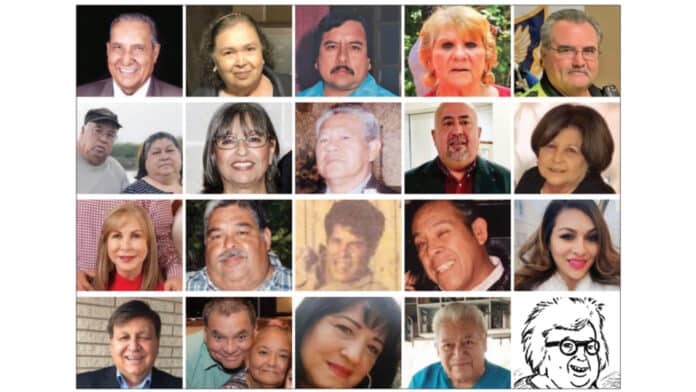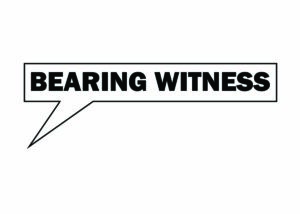
 There have been 2,629 deaths related to COVID-19 in Hidalgo County since the pandemic struck the region nearly a year ago. But with near-daily updates sharing the growing numbers of cases, deaths and hospitalizations, the actual toll the virus has had on the community may get lost in the numbers.
There have been 2,629 deaths related to COVID-19 in Hidalgo County since the pandemic struck the region nearly a year ago. But with near-daily updates sharing the growing numbers of cases, deaths and hospitalizations, the actual toll the virus has had on the community may get lost in the numbers.
Chief Executive Officer Francisco Guajardo of the Museum of South Texas History in Edinburg took it upon himself to look deeper, not only to document the effects the pandemic has had on local residents, but to paint a more intimate picture of the devastation left in the wake of the coronavirus and humanize the victims and their families.
Together with MOSTHistory Exhibits Coordinator Melissa Peña, Guajardo created the Bearing Witness series in partnership with The Monitor, which together with sister publications The Brownsville Herald and Valley Morning Star published the museum’s stories about the victims of the disease.
“The reason why it was brought up to begin with was at the beginning of the pandemic, I started a COVID-19 collection,” Peña said. “I was pulling in official documentation and materials that our county was putting out or the state of Texas was putting out. We noticed that it was very cold and bland. We’d seen how people had come to the museum looking for anything on the last pandemic which was the Spanish influenza, and we didn’t really have anything.”
Now, after telling 20 stories of 22 people who died because of the virus, the weekly series published every Monday will come to an end.
Concluding Monday, Bearing Witness told heartbreaking stories of families who lost several members to COVID-19, others whose mothers and fathers died, and more recently a comic strip from a Seattle author and cartoonist so moved by the series he decided to honor his uncle, Cruz Huijon, in his own unique way.
In fact, Bearing Witness is ending with another comic strip in Monday’s newspaper, an illustration that will honor the lives of several more individuals before saying farewell.
For Peña, the series accomplished what cold hard numbers could never achieve: sentiment.
Specifically, she said the culture of the Rio Grande Valley — one rooted in family, warmth and hospitality — was not being conveyed in the statistics shared by the governing bodies. This inspired her and Guajardo to create the series.
“In addition to building a collection on the pandemic, we thought that we wanted to write up stories on people who were dying,” Guajardo said. “When the conversation began around writing up stories, doing stories that recognized, stories that uplifted people who had been victimized by COVID-19, we thought, ‘Why don’t we interview family members who can give us context and background to these people who were dying?’”
Guajardo and Peña took these stories and wrote them as a way to celebrate their lives, people who Guajardo said had their lives unceremoniously taken.
The first entry in the series was published Oct. 12, 2020, and featured Amado Garcia, who died due to the disease on Aug. 22. His son, Abel Garcia, said that the series helped his family not only with the publication of his father’s story, but in reading the stories from other families with shared tragedy.
“It really helped us to reflect positively on the whole situation. Even though it’s a hard situation, we felt it was a celebration of my father,” Garcia said. “As I read other people’s stories, it was a real nice cross-section of our population — our community. To know that my dad was part of this community and people got to hear his story meant a lot to us.
He said each member of his family received a copy of the newspaper with his father’s story. Some had it framed.
“It meant a lot that our father was in the first article because of the timing of it,” Garcia said. “It was the timing of it that really helped us heal as a family. Seeing how it was featured and the honor it had in it, the love message that it had and all the other articles did too, it wasn’t just about showing people the different residents who had lost their lives. It was showing how those people impacted others and what love did for them.
“It was great. It was really great. We really, truly appreciated that he was first. We felt very honored that our father was chosen to be the first one in the series.”
Guajardo said that another source of inspiration for the series was the loss of a museum staff member, Sandra Luna, who died in July 2020. When it came time to give the series a name, he said “Bearing Witness” was chosen because the series would feature people who witnessed the loss of their loved ones.
“It’s important that we bear witness to people, and then we talk about it,” Guajardo said.
Each entry was compiled by Guajardo and Peña, who interviewed family members on their own time when they weren’t working with the museum. The process usually consisted of an interview conducted via Zoom, which was recorded and archived by the museum.
Guajardo and Peña collaborated on the writing process along with the families, with some relatives deciding to pen their own stories.
“This was really about helping the family to heal,” Guajardo said.
He added that he hoped that the stories would also create understanding in the community by showing that the virus was something real and should be taken seriously.
“We wanted to write about people who were very under the radar,” Guajardo said. “We were not interested in the high-profile people because those people get enough attention. We wanted to do completely under the radar people and uplift their lives. That’s what we wanted to do because that’s what most of us are like.
“… Every single one of the stories was memorable and emotional and moving. I don’t remember a single one that wasn’t.”
Peña said the work moved her to tears as she understood the gravity of the losses felt by the families, the circumstances in which some didn’t have the opportunity to say goodbye to their loved ones, and the despair of having no means of consoling the people left behind.
“I’m going to say right off the bat, I cried every single time,” Peña said. “I cried with the family because they cried, and then Francisco would write the piece and I would cry again. I can say that if I didn’t cry, then we would go back and rework the piece. Like, OK, we need to tell the story a little differently.”
Recognizing that the work should aim to be as profound as the losses the museum was documenting, she noted the importance of empathizing with the families while penning the stories.
“You relate to each one of them when you’re sitting there talking to this person who’s lost someone to this insane pandemic, you can’t help but think of your own mom or your uncle,” Peña said. “Also, we’re doing this over Zoom, so you can’t reach out and touch them and hold their hand through it or give them a hug or comfort them in some way. You’re sitting there staring at your computer screen, and it’s just a sense of helplessness.”
Jessica Saenz lost her sister Heidi unexpectedly on Aug. 3, 2020 Her story was featured in the Bearing Witness series on Jan. 17.
“It was a very unexpected thing,” Saenz said. “I don’t know if ‘validated’ is the right word, but it validated not just my sister’s life, but all the other people that we read about. They mattered. They were important. They were real. I think that maybe people reading about them and about this thing not discriminating, not caring about how old you are — young; old; weak; strong; sick; healthy — it’s just going to get you.”
Saenz added that the series made the pandemic more real for people and hopefully more cautious. She said Bearing Witness also helped her family cope with their loss, particularly Heidi’s 9-year-old daughter Madison, who keeps a copy of her mother’s story in a sheet protector.
“All I can say is that it gave a face to the virus,” Saenz said. “These were real people going about their daily business, being careful and yet they still got sick and they died. I was really impressed with the series.”
Guajardo said he hopes he was able to convey the sense of family and resiliency that is characteristic of Valley residents. He said that Bearing Witness now serves as a reminder of the power of family and the power of community in the face of unprecedented struggle.
“It was being there for each other,” Guajardo said. “I was reminded of that time and again through these interviews.”
Stephan Wingert, publisher of AIM Media Texas’ daily newspapers The Monitor, Valley Morning Star and Brownsville Herald, considered it their responsibility to the Valley community to partner with MOSTHistory in its endeavor to honor and remember the victims and their families.
“If we’re only recording the death tolls, case tallies and hospitalization rates of this horrific disease, then we’re not doing our job,” Wingert said. “We believed in the museum’s idea to honor the dead, and felt it was our duty to highlight their work and the lives lost by putting them in print — embedding their names in recorded history for generations to know who and what we lost.
“We thank Francisco and his staff at MOSTHistory for their work, and of course the families who participated in an effort we and the entire community won’t forget.”




